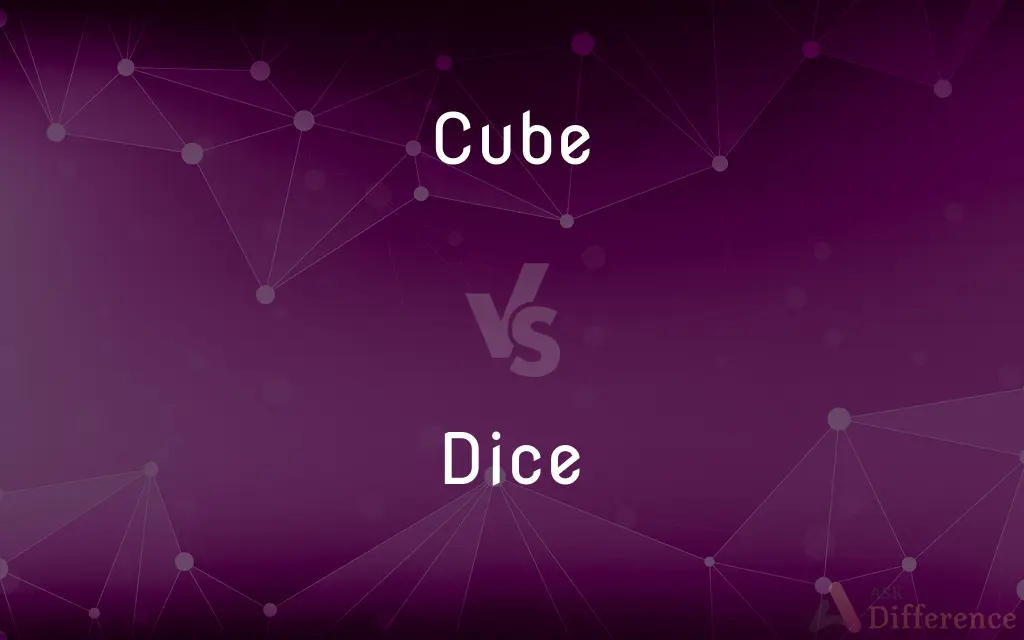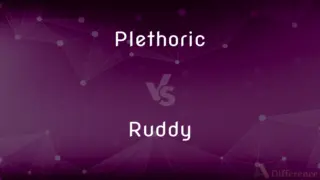Cube vs. Dice — What's the Difference?
By Tayyaba Rehman — Updated on October 25, 2023
A cube is a three-dimensional geometric shape with six equal square faces, while "to dice" means to cut food into small cubes, and "dice" also refers to small, throwable objects with marked sides used in games.

Difference Between Cube and Dice
Table of Contents
ADVERTISEMENT
Key Differences
A cube is a well-defined geometrical figure in the realm of mathematics and art. This three-dimensional shape boasts equal lengths on all sides and always has six equal square faces. Dice, on the other hand, are small objects that most often adopt the cube's shape, and they're commonly thrown in games to produce random outcomes.
At a glance, the primary distinction between cube and dice lies in their purpose and context. A cube typically alludes to a geometrical or spatial entity, intrinsic to studies in fields like mathematics, architecture, and design. Dice, however, are generally associated with the realm of gaming and leisure, serving as tools to introduce an element of chance.
While cubes emphasize dimensions and spatial properties, dice are more about function and play. Dice, though usually cube-shaped, are marked on each face with one to six dots, symbolizing numbers. These markings are vital for determining outcomes in games. Cubes, being more abstract, don't typically carry such specific markings unless they are being used as dice.
To further complicate matters, "dice" can also serve as a verb in English. When someone says they're "dicing" something, it often means they're cutting it into small cube-like pieces, especially in a culinary context. The cube's shape thus influences the verb's meaning, bridging the conceptual gap between these two terms.
In essence, while both cube and dice share a connection in their cubic shape, they diverge significantly in purpose, symbolism, and context. The cube stands as a foundational shape in geometry, while dice offer chance and strategy in games and a culinary technique in the kitchen.
ADVERTISEMENT
Comparison Chart
Definition
A three-dimensional geometric shape.
Small throwable objects with marked sides for games or the act of cutting food into small cubes.
Purpose
Represents spatial properties in mathematics and design.
Used for generating random outcomes in games or as a culinary technique.
Markings
Typically plain, without specific markings.
Often have dots representing numbers from one to six.
Context
Common in mathematics, art, and architecture.
Associated with games, randomness, and culinary arts.
Associated Action
None specific, but can be measured, drawn, or built.
Can be thrown (in games) or refers to the act of cutting (in cooking).
Compare with Definitions
Cube
A three-dimensional shape with six equal square faces.
She built a model using several colorful cubes.
Dice
A game played using dice.
They gathered around to play a quick game of dice.
Cube
To multiply a number by itself twice.
To find the volume, you need to cube the length.
Dice
To cut food into small cube-shaped pieces.
He diced the onions finely for the salsa.
Cube
The product of a number multiplied by itself twice.
The cube of 3 is 27.
Dice
The plural form of die, referring to the gaming object.
He threw the dice and awaited his fate.
Cube
To cut food or other substances into small, cube-shaped pieces.
She decided to cube the steak for the stew.
Dice
To play a game that involves throwing dice.
They decided to dice for who pays the bill.
Cube
In geometry, a cube is a three-dimensional solid object bounded by six square faces, facets or sides, with three meeting at each vertex. The cube is the only regular hexahedron and is one of the five Platonic solids.
Dice
Dice (singular die or dice) are small, throwable objects with marked sides that can rest in multiple positions. They are used for generating random numbers, commonly as part of tabletop games, including dice games, board games, role-playing games, and games of chance.
Cube
(Mathematics) A regular solid having six congruent square faces.
Dice
Plural of die2.
Cube
Something having the general shape of a cube
A cube of sugar.
Dice
Pl. dice also dices (used with a pl. verb) Small cubes of food.
Cube
A cubicle, used for work or study.
Dice
To play or gamble with dice.
Cube
(Mathematics) The third power of a number or quantity.
Dice
To win or lose (money) by gambling with dice.
Cube
Cubes(Slang) Cubic inches. Used especially of an internal combustion engine.
Dice
To cut (food) into small cubes.
Cube
(Mathematics) To raise (a quantity or number) to the third power.
Dice
To decorate with dicelike figures.
Cube
To determine the cubic contents of.
Dice
(uncountable) Gaming with one or more dice.
Cube
To form or cut into cubes
The cook cubed some potatoes.
Dice
A die.
Cube
To tenderize (meat) by breaking the fibers with superficial cuts in a pattern of squares.
Dice
That which has been diced.
Cut onions, carrots and celery into medium dice.
Cube
(geometry) A regular polyhedron having six identical square faces.
Dice
(intransitive) To play dice.
Cube
Any object more or less in the form of a cube.
A sugar cube
A stock cube
Dice
(transitive) To cut into small cubes.
Cube
(mathematics) The third power of a number, value, term or expression.
The cube of 2 is 8
Dice
(transitive) To ornament with squares, diamonds, or cubes.
Cube
(computing) A data structure consisting of a three-dimensional array; a data cube
Dice
To play games with dice.
I . . . diced not above seven times a week.
Cube
A Rubik's cube style puzzle, not necessarily in the shape of a cube
Dice
To cut into small cubes; as, to slice and dice carrots.
Cube
A cubicle, especially one of those found in offices.
My co-worker annoys me by throwing things over the walls of my cube.
Dice
To ornament with squares, diamonds, or cubes.
Cube
To raise to the third power; to determine the result of multiplying by itself twice.
Three cubed can be written as 33, and equals twenty-seven.
Dice
Small cubes with 1 to 6 spots on the faces; used to generate random numbers
Cube
(transitive) To form into the shape of a cube.
Dice
Cut into cubes;
Cube the cheese
Cube
(transitive) To cut into cubes.
Cube the ham right after adding the curry to the rice.
Dice
Play dice
Cube
(intransitive) To use a Rubik's cube.
He likes to cube now and then.
Dice
Small throwable objects with marked sides used for random outcomes in games.
She rolled the dice and hoped for a six.
Cube
A regular solid body, with six equal square sides.
Cube
The product obtained by taking a number or quantity three times as a factor; as, 4x4=16, and 16x4=64, the cube of 4.
Cube
To raise to the third power; to obtain the cube of.
Cube
A three-dimensional shape with six square or rectangular sides
Cube
A hexahedron with six equal squares as faces
Cube
The product of three equal terms
Cube
Any of several tropical American woody plants of the genus Lonchocarpus whose roots are used locally as a fish poison and commercially as a source of rotenone
Cube
A block in the (approximate) shape of a cube
Cube
Raise to the third power
Cube
Cut into cubes;
Cube the cheese
Cube
A block of something, especially one shaped to aid use.
She added a chicken bouillon cube to the soup.
Common Curiosities
Are all dice cubes?
While many dice are cube-shaped, not all are; dice can have different numbers of sides.
Can the term "cube" refer to a mathematical operation?
Yes, to cube a number means to multiply it by itself twice.
What are the basic characteristics of a cube?
A cube is a three-dimensional shape with six equal square faces.
What's the primary purpose of dice in games?
Dice introduce an element of chance by producing random outcomes when thrown.
Is there a connection between the shape of a cube and the action of dicing food?
Yes, to dice food means to cut it into small, cube-shaped pieces.
What are the dots on dice called?
The dots on dice are called pips.
Do cubes always have equal sides?
Yes, a cube always has six equal square faces.
Can the term "cube" be used in cooking?
Yes, "to cube" in cooking means to cut food into cube-shaped pieces.
Are dice only used for games?
While primarily used in games, dice can also be used in decision-making, teaching, and simulations.
What's the difference between "dice" and "die"?
"Dice" is the plural form, and "die" is the singular. So, one die and two dice.
How many edges does a cube have?
A cube has 12 edges.
Can dice have more than six sides?
Yes, there are dice with various numbers of sides, like 10-sided or 20-sided dice.
Is a cube always solid?
Not necessarily; a cube can be hollow or solid, but its defining feature is its shape.
Are dice always made of plastic?
No, dice can be made of various materials, including bone, wood, metal, and plastic.
What does "cubed" mean in math?
"Cubed" refers to raising a number to the third power, which means multiplying the number by itself twice.
Share Your Discovery

Previous Comparison
Plethoric vs. Ruddy
Next Comparison
Join vs. ConnectAuthor Spotlight
Written by
Tayyaba RehmanTayyaba Rehman is a distinguished writer, currently serving as a primary contributor to askdifference.com. As a researcher in semantics and etymology, Tayyaba's passion for the complexity of languages and their distinctions has found a perfect home on the platform. Tayyaba delves into the intricacies of language, distinguishing between commonly confused words and phrases, thereby providing clarity for readers worldwide.
















































